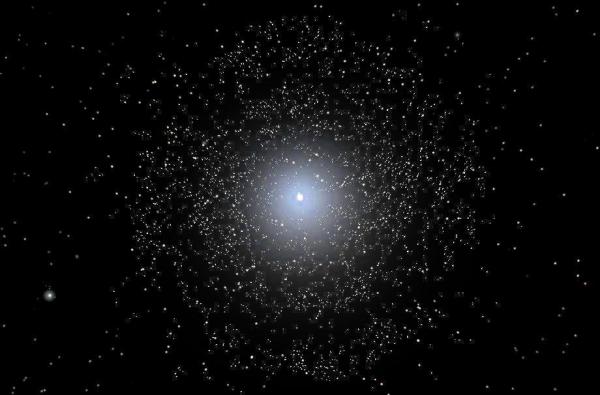BY LETTER
Alfirk Panvirtuality Swarm
Galactography > Cybercosm, The
Galactography > Other Major Polities, Empires, and Meta-Empires > Solipsist Panvirtuality
Galactography > Systems and Worlds > Systems & Worlds A - B
Sophonts > Modosophonts > Virtuals
Galactography > Other Major Polities, Empires, and Meta-Empires > Solipsist Panvirtuality
Galactography > Systems and Worlds > Systems & Worlds A - B
Sophonts > Modosophonts > Virtuals
Solipsist Panvirtuality swarm with some degree of contact with the Sephirotic Empire worlds nearby. | |
 Image from Steve Bowers | |
| Alfirk A swarm with Alfirk B nearby | |
Alfirk (Beta Cephei A) -Data Panel | |
| Distance from Sol | 600 ly |
|---|---|
| Star 1 | Alfirk A: class B1 : luminosity 14,600 x Sol |
| Star 2 | Alfirk B: class A5: luminosity 25 x Sol |
| Star 3 | Alfirk C: class A5: luminosity 41 x Sol |
A rare insight into a Solipsist Panvirtuality dataswarm.
The Panvirt-o-phile faction on Alfirk C
The human-derived colony at Alfirk C, an A-class star 600 light years from Earth, was very conscious of the fact that their star was in a binary system with the bright variable Alfirk A, and that this bright star had long supported a colony of secretive aioids, members of the Solipsist Panvirtuality empire. For more than a millennium the Panvirts made no meaningful contact with the humans in this system, but as the Alfirk C colony became more technologically sophisticated, a small but significant fraction of the society converted themselves into digital form. Among this virtual human population, a certain curiosity arose about the massive dataspaces that existed in orbit around their companion star, 2400 AU distant. A second companion star, Alfirk B, orbited much closer to the variable, (only 45 AU distant) but this star was also claimed by the Panvirts.The most prominent of the virtual human Panvirt-o-phile faction was a former biologist named Alyx Tuerge. Tuerge spent many centuries attempting to contact the nearby panvirtual colony, without success; over this time the Solipsists increased the density of the computronium swarm surrounding the A+B stars until their light was visibly attenuated. Eventually the Panvirts responded, in 5441 AT; Tuerge gradually built up a dialogue with the entities inside the massive swarm, until at last ve was invited to enter the a-humans' cybercosm. Tuerge spent twenty years inside this megastructure, but eventually returned to give one of the earliest and most detailed accounts of the virtual aioid cosm contained within a Solipsist Panvirtuality swarm. Using his taxonomic training Tuerge described the extraordinary universe he found there, in a treatise which has become a classic.
The Alfirk A Cybercosm Examined
Tuerge stated that, at first, ve could not understand the flood of data that ve encountered on entering the Panvirtual cybercosm. Vis operating program had already been rewritten extensively in order to function in the Panvirt processing substrate, but still most of the sense impressions that entered vis consciousness were beyond comprehension.The cosm seemed to consist of a morass of brightly coloured, solid yet interpenetrating clouds, interspersed with mathematical shapes, which seemed to signify different concepts and ideas, none of which Tuerge could yet understand. But very soon ve became aware that these mathematical cloudscapes were populated by a range of intelligent entities, all seemingly different, and all with a particular role to play.
 Image from Keith Wigdor and Bing Image Creator | |
| A small swarm of Myopics, Recorders and Researchers surround a massive Cryptomorph in the Alfirk cybercosm | |
Myopics
The most frequently encountered infomorphs in this cosm are the Panvirtual equivalent of modosophonts; these beings are only capable of perceiving a restricted fraction of the data available within the environment, so Tuerge called them the Myopics. These beings are motivated primarily by a desire to experience the range of sensations permitted by the virtual environment, which is constantly changing. Tuerge noted that Myopics are a diverse lot, and show a range of abilities and preferences, which (as ve eventually discovered) allows them to specialise in certain tasks, and eventually to progress towards a higher state of being, becoming one of the many specialised entities in this environment.Investigative Infomorphs
Because the simulated environment is subject to such continual, rapid change, the most common of the specialised infomorphs are those who specialise in examining and recording the qualities of that environment. Tuerge called these Researcher and Recorder infomorphs; these are responsible for testing the environment experimentally, and updating the extensive libraries concerning the changing physical laws and phenomena they discovered. Other, more advanced infomorphs correlate this data and speculate about the phenomenology involved; these Tuerge labelled Integrators and Theoretician infomorphs.To regulate and cross-check these investigative entities, a separate group of specialists examine all the data produced by the experimentalists; these were given the name Falsifiers and Questioners, both groups which pick apart the findings of the other investigators. Tuerge observed that the flow of data between these entities was such an important part of the datasphere that it was apparent as a flow of luminous colours, most of which had no equivalent in vis previous experience.
These Investigative infomorphs respond to the characteristics of the virtual environment in this cosm, by formulating theories concerning the underlying hidden laws that govern its behaviour. Since this behaviour is constantly changing, these theories are formulated rapidly, in an ad hoc fashion, and are quite often wrong. Among the Myopics different factions of believers and supporters argue over the relative merits of the current theories, and attempt to respond to the environment according to their favourite beliefs. Quite often these beliefs are inadequate to predict the behaviour of the environment sufficiently well to ensure the safety of the infomorphs, and they suffer virtual injury, dataloss or even dissolution. For this reason most infomorphs of all kinds exist in multiple instances, which share experiences whenever the cybercosm permits such data transfers.
Influential Infomorphs
Operating at a higher level than the Investigative infomorphs are those entities who can influence the characteristics of the environment, directly or indirectly; the Influentials. Some work to maintain the stability of the environment, known as Maintainers; others work to increase the comfort level in the environment, known as Ameliorators. But the constant changes that Tuerge experienced during his time in the Alfirk cosm strongly suggested that the Maintainers and Ameliorators are subordinate to those entities who desire and actively promote change. A particularly powerful group, labelled the Exuberants by Tuerge, constantly work to increase the complexity of the environment; they generally do not change the underlying laws of the cosm much, unless it is to allow more and varied phenomena in a particular perceptual volume.Another powerful group promote and exaggerate the effects of random change in the cosm; these Tuerge called the Stochastics, although they are a varied and variable set in themselves. Some stochastics seem to take delight in reversing the efforts of other Influential infomorphs; Tuerge called these the Contrarians.
Several groups of influential infomorphs were never observed by Tuerge, and these he called Cryptomorphs; these are rumoured to control the long term trends in the characteristics of the virtual environment, and are possibly in contact with, or controlled by, the equivalent of transapient Panvirt beings. Other entities are of more doubtful status, and work to spread confusion and chaos in the environment by creating deceptive or rapidly changing qualities in the characteristics of the environment. Tuerge called these entities Tricksters; ve observed very few of this group directly, but found them both impressive and daunting.
Other Forms
Independent of those entities which investigate or influence the changing virtual environment are some which apparently have other priorities. Vast, solitary and incommunicative, the Hermit infomorphs embody the solipsist philosophy of the Panvirtuality. These beings seem to be impervious to any of the environmental cataclysms occurring all around them, but on occasion they release an infoburst of great profundity and relevance. Despite their apparent inward focus the Hermit infomorphs evidently have an intimate knowledge of events in the cybercosm.Dangerous subsentient programs called Infovores prey upon the intelligent infomorphs, over time assimilating enough competence to become sophont entities themselves. Some become Myopics, and eventually investigators or influentials; others remain predators in the sophont stage and became fearsome entities labelled Destroyers by Tuerge. Opposite in nature to the Destroyers are the Conserver Infomorphs; these gather and preserve sentient programs and other data, but do not appear to do anything constructive with them. Perhaps they are retaining these programs for use at a much later date.
Tuerge classed another widespread subsentient morph group as Infotrophs; these systems generate data in vast streams, varying in quality according to the prevailing characteristics of the environment at the time. Tuerge did not observe any infotroph develop sentience; they appear to fill a niche in the information ecology similar to plant life, or perhaps zooplankton.
Following vis sojourn in the Panvirtual dataswarm, Tuerge spent several standard years readjusting back to (virtual) human society. At length ve extended vis processing capacity considerably, and produced the famous treatise and a host of supporting data which has given a valuable insight into the shadowy world of the Panvirtual Empire. Other pioneers have made similar forays into Solipsist dataswarms elsewhere since that time, and found that each swarm is very different, while at the same time having certain almost indefinable qualities in common.
Related Articles
Appears in Topics
Development Notes
Text by Steve Bowers
Initially published on 04 July 2009.
To download Alfirk Dyson Swarm for Celestia, click this link and download it into Celestia's Extras folder
Alfirk in Celestia
then follow this CEL link Somewhere near Alfirk Dyson Swarm
You can download Celestia from here
Initially published on 04 July 2009.
To download Alfirk Dyson Swarm for Celestia, click this link and download it into Celestia's Extras folder
Alfirk in Celestia
then follow this CEL link Somewhere near Alfirk Dyson Swarm
You can download Celestia from here






